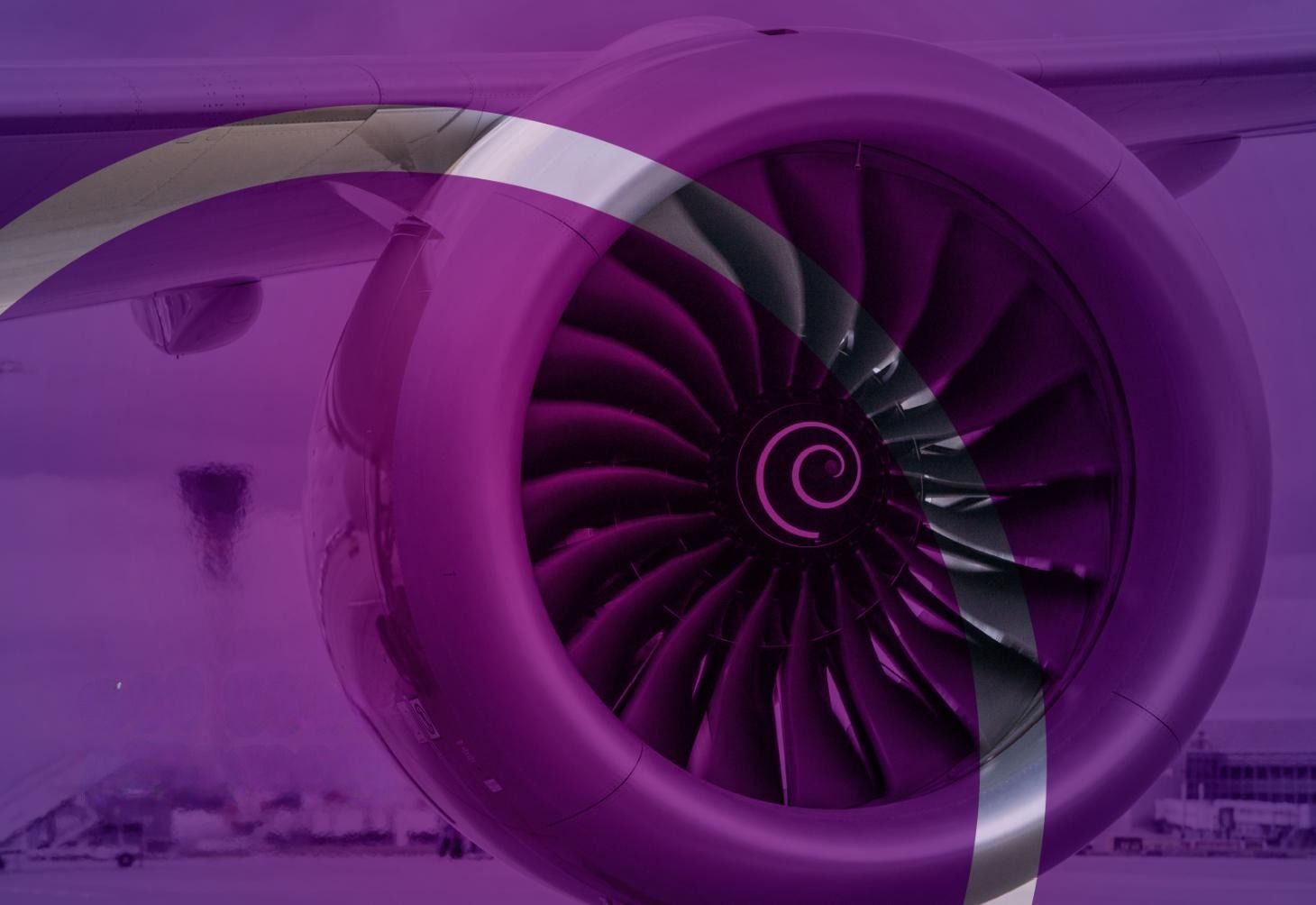
Understand your emissions, support climate solutions
Upload your flight information to understand the carbon impact of your travel and to then support climate solutions like sustainable aviation fuel (SAF) and certified reforestation projects.

At Heathrow, we believe we should all understand our impact on the environment and do what we can to support its protection. We want to make it easier for you to understand the carbon impact of your travel and easier for you to take action on that carbon footprint by supporting climate solutions.
Support climate solutions with Heathrow
Sustainable aviation fuel (SAF) describes non-conventional jet fuels produced from more sustainable resources, like agricultural waste. SAF has a lower net carbon footprint as compared to conventional fuels, and depending on the feedstock and other specifics, SAF has the potential to meaningfully reduce the carbon intensity of flying. To accelerate aviation’s transition to a lower-carbon future, Heathrow invites all travellers to act on the carbon footprint of their flights by supporting a combination of SAF and high-quality reforestation projects.

What is a carbon footprint?
A carbon footprint is the greenhouse gas (GHG) emissions arising from a specific activity, such as your flight. The CO2 emissions of a flight depend on the aircraft used, the distance flown and the amount of passengers and cargo the aircraft carries.
How do you calculate my flight's carbon emissions?
Our carbon emissions calculations follow the International Air Transport Association (IATA) Recommended Practice - RP 1726 and take into account parameters such as all scheduled flights, aircraft fuel consumption and seat configuration, and historical load factors for more than 400 airlines. Precision of the calculation depends on the input data.
What type of climate solutions can I support through this programme?
By uploading your itinerary to the carbon app on this page, we will automatically calculate the carbon footprint of your flight. You can then choose how you want to address your carbon footprint through a combination of certified reforestation projects (carbon offsetting) and sustainable aviation fuel (SAF).
What is sustainable aviation fuel?
SAF, or Sustainable Aviation Fuel, is a substitute for traditional fossil fuels used in aviation. It is produced from sustainable resources such as agricultural waste and is known as a "drop-in" fuel because it does not require any changes to the aircraft or infrastructure. Compared to fossil fuels, SAF can reduce carbon emissions by up to 80%, making a significant impact on the industry's carbon footprint and dependence on fossil fuels. Some of the benefits of SAF include lower emissions of CO2, particulates, and sulfur, and it can be produced from a variety of sustainable resources. SAF can be referred to as a biofuel or synthetic fuel depending on the feedstock used to produce it. SAF meets the same safety and quality standards as traditional fossil jet fuel and has been used in over 400,000 flights. While SAF can reduce carbon emissions by up to 80%, it is also possible to achieve 100% reduction in emissions by replacing a greater proportion of fossil jet fuel with SAF.
How do you guarantee that SAF is sustainable?
SkyNRG is responsible for SAF. Its operations have been certified by the Roundtable on Sustainable Biomaterials (RSB), which is a worldwide initiative. Bringing together farmers, corporations, NGOs, experts, governments, and inter-governmental agencies concerned with ensuring the sustainability of biomass production. RSB is widely accepted as the “gold standard” of voluntary certification schemes. SkyNRG is advised by an independent Sustainability Board, which includes representatives from WWF (World Wide Fund for Nature), the European Climate Foundation, Solidaridad, and the University of Groningen. SkyNRG also works with a global NGO network for the latest developments in sustainability.
How is my flight's carbon emissions reduced when flying on SAF?
Even when flying on SAF, an aircraft engine still emits CO2. However, the sustainable resources used to produce SAF recycle the CO2 emitted previously. It’s the short time needed to recycle carbon emissions that make the biggest difference.
Is it safe to fly on SAF?
Absolutely. SAF meets exactly the same quality and safety requirements as fossil jet fuel. Over 400,000 flights have already been flown using SAF.
What is carbon offsetting, and how does it work?
Carbon offsetting enables individuals and organisations to take climate action by voluntarily supporting certified third-party projects that contribute to the reduction, avoidance, or removal of GHG emissions.
Certified carbon projects issue carbon credits. Each carbon credit, carbon offset, or emission reduction unit represents a single unit of GHG emissions (being one (1) tonne carbon dioxide equivalent (tCO2e)) that is reduced, avoided, or removed from the atmosphere. A unit of GHG emissions can be reduced, avoided, or removed through various methods or project types (e.g. forestry projects, landfill methane recovery and destruction).
Carbon offsetting provides financing for these certified carbon projects. The purchase of a carbon offset or carbon credit enables the buyer to offset their GHG emissions by contributing to these projects that reduce, avoid, or remove GHG emissions elsewhere in the world.
A claim to have offset emissions is validated under a set of rigorous conditions – the emissions reductions, avoidances, or removals must be additional, measurable, auditable, permanent, and unique. The certification process for a carbon offset project is robust.
Will addressing my carbon emissions really make a difference?
Addressing climate change at the scale and pace needed requires us to immediately avoid new GHG emissions (or reduce emissions) as well as to remove GHG emissions from the atmosphere and / or the carbon cycle.
When you offset the carbon footprint of your flight, you support climate solutions like nature-based solutions, renewable energy projects, or community projects that reduce or remove carbon emissions – and in this way help to further climate action around the world.
As for SAF, SAF has the potential to meaningfully reduce the carbon intensity of flying in the short- and medium-term. When you contribute to SAF here, you help demonstrate demand for more sustainable fuel and accelerate the adoption and production of this important fuel source for lowering the carbon emissions associated with flying.
What will happen with my climate contribution?
The funds paid support climate solutions (SAF and verified offsets) that reduce or remove greenhouse gas (GHG) emissions in an amount equivalent to that of your estimated carbon footprint. The price you pay is the total cost to deliver the carbon offset and SAF claims.
What if the airline I'm flying with already use SAF, or offset their flights?
Some airlines already address CO2 emissions for some flights or ticket types. Travellers can check with their airline about what action has already been taken. The service offered through this webpage is intended to be supplementary to other programs offered by airline operators.
Who is CHOOOSE™?
This service is hosted by climate tech company CHOOOSE™. CHOOOSE delivers a software platform that enables both individuals and organisations to understand their carbon footprint, make more carbon-informed decisions, and support trusted climate solutions around the world. For more information, please visit chooose.today.
Who is SkyNRG?
Since 2009, SkyNRG has been building up SAF capacity and production for the industry to meet its 2050 net zero commitment. SkyNRG has supplied SAF to over 40 airlines across the world and is now developing dedicated SAF production facilities to support the transition from fossil jet fuel to sustainable aviation fuel. SkyNRG does not compromise when it comes to sustainability; we are a globally recognized Certified B Corp(TM), our operations are certified by the Roundtable on Sustainable Biomaterials (RSB), and we are advised by an independent Sustainability Board, as well as a worldwide NGO network to ensure we make the right sustainability decisions across all of our operations. For more information about SkyNRG, please visit their website.
